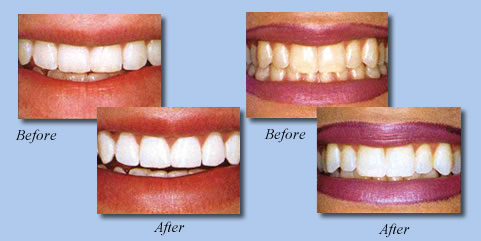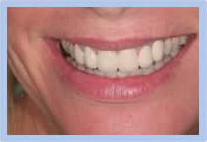About Bonding
 Bonding consists of the adhesion of a composite resin material to tooth structure. This technique can effectively enhance appearance when used as fillings or small additions to the enamel surface. Bonding can also be used to cement a thin “finger-nail” of composite or porcelain material onto the surface of the tooth (direct bonding, laminates, and veneers). The use of veneers can effectively enhance a patient’s appearance when used appropriately. However, there are significant disadvantages to veneers that must be taken into consideration. First, Veneers and Laminates almost always make the teeth larger because it is impossible to remove enough enamel surface to compensate for the thickness of these materials. Bonding experts know that composite materials bond strongly only to the enamel layer. There is far less cohesion of bonding materials to the underlying dentin layer of tooth structure. Because only the outer surface of the teeth is being changed, there is less flexibility in altering tooth size, shape and position than with jacket restorations (crowns). Bonded restorations are never the treatment of choice for people with periodontal problems because larger teeth will place more stress on an already weak foundation. Bonded restorations, however, are suitable for young patients. Young patients can tolerate any increases in tooth size better than older patients. They may do better with bonded restorations than jacket restorations (crowns) because the larger nerves in their teeth are more likely to require root canal therapy than the teeth of older adults. However, all patients who have veneers or laminates are committed to crown restorations in the future, because the teeth have been irreversibly cut and there will come a time when bonded restorations will not be proper treatment. Bonded restorations have not been around as long as jacket restorations (crowns) and cannot compare to the track records that crowns have enjoyed over the last 50 years.
Bonding consists of the adhesion of a composite resin material to tooth structure. This technique can effectively enhance appearance when used as fillings or small additions to the enamel surface. Bonding can also be used to cement a thin “finger-nail” of composite or porcelain material onto the surface of the tooth (direct bonding, laminates, and veneers). The use of veneers can effectively enhance a patient’s appearance when used appropriately. However, there are significant disadvantages to veneers that must be taken into consideration. First, Veneers and Laminates almost always make the teeth larger because it is impossible to remove enough enamel surface to compensate for the thickness of these materials. Bonding experts know that composite materials bond strongly only to the enamel layer. There is far less cohesion of bonding materials to the underlying dentin layer of tooth structure. Because only the outer surface of the teeth is being changed, there is less flexibility in altering tooth size, shape and position than with jacket restorations (crowns). Bonded restorations are never the treatment of choice for people with periodontal problems because larger teeth will place more stress on an already weak foundation. Bonded restorations, however, are suitable for young patients. Young patients can tolerate any increases in tooth size better than older patients. They may do better with bonded restorations than jacket restorations (crowns) because the larger nerves in their teeth are more likely to require root canal therapy than the teeth of older adults. However, all patients who have veneers or laminates are committed to crown restorations in the future, because the teeth have been irreversibly cut and there will come a time when bonded restorations will not be proper treatment. Bonded restorations have not been around as long as jacket restorations (crowns) and cannot compare to the track records that crowns have enjoyed over the last 50 years.
Whitening Teeth

Bleaching can substantially whiten natural teeth as long as the discoloration is close to the surface. It does not have an affect on dental restorations.
Take-home bleaching is safe as long as it is not abused. A custom-made tray holds the bleach uniformly against the teeth so that it can effectively whiten them. There is some evidence that over-bleaching of teeth can weaken the enamel structure, but take-home bleaching has proven to be quite safe.
In-office bleaching techniques usually employ caustic chemicals and great care must be taken to avoid contact of these chemicals with the gums. Although in-office bleaching works much faster than take-home bleaching, it is advisable to try take-home bleaching first.
Jacket Restorations

Esthetics Are Part of All Restorations
We strive for maximum esthetics regardless of the material being used or type of case. Our porcelain-to-metal jackets and bridgework do not show that “black line” because margins are placed way under the gum close to the bone. While changes can occur that expose metal margins, these changes generally occur gradually. It is important for patients to accept the reality that at some point dentistry may need to be remade if significant changes occur. There are some patients who wear dental restorations for more than 40 years that don’t require replacement because the changes have been minimal. Others must replace dentistry after 10 to 15 years in order to compensate for the changes that have occurred. Successful dentistry preserves the teeth so that they will be able to support new restorations when replacement is required.
